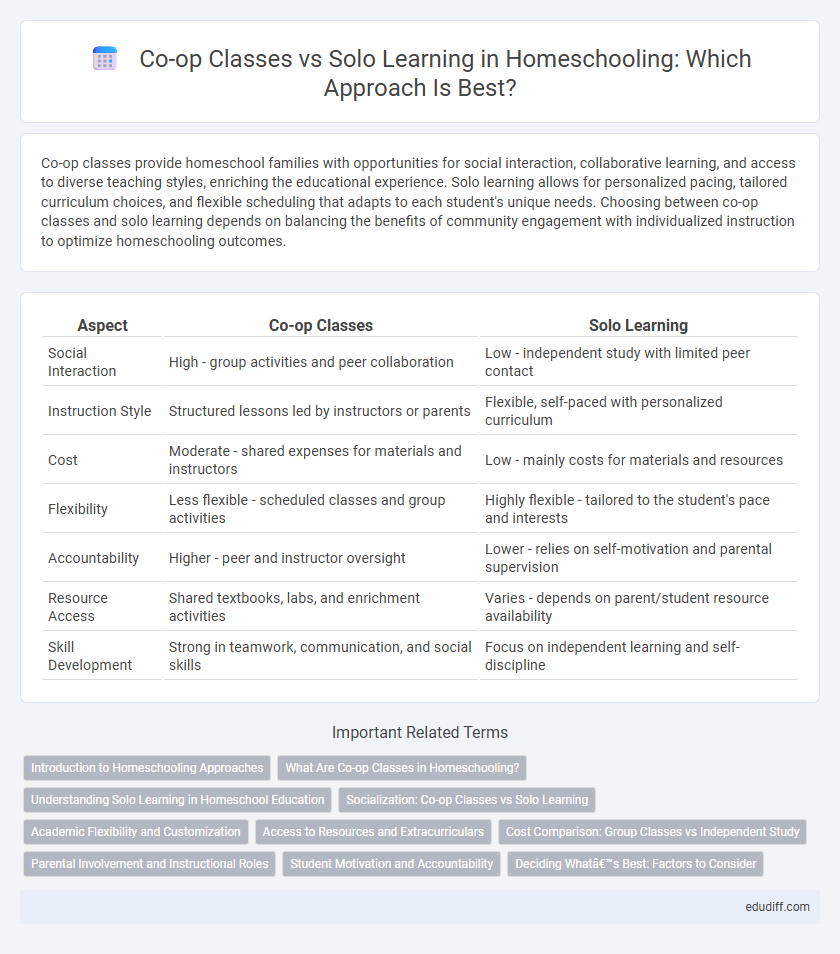Co-op classes provide homeschool families with opportunities for social interaction, collaborative learning, and access to diverse teaching styles, enriching the educational experience. Solo learning allows for personalized pacing, tailored curriculum choices, and flexible scheduling that adapts to each student's unique needs. Choosing between co-op classes and solo learning depends on balancing the benefits of community engagement with individualized instruction to optimize homeschooling outcomes.
Table of Comparison
| Aspect | Co-op Classes | Solo Learning |
|---|---|---|
| Social Interaction | High - group activities and peer collaboration | Low - independent study with limited peer contact |
| Instruction Style | Structured lessons led by instructors or parents | Flexible, self-paced with personalized curriculum |
| Cost | Moderate - shared expenses for materials and instructors | Low - mainly costs for materials and resources |
| Flexibility | Less flexible - scheduled classes and group activities | Highly flexible - tailored to the student's pace and interests |
| Accountability | Higher - peer and instructor oversight | Lower - relies on self-motivation and parental supervision |
| Resource Access | Shared textbooks, labs, and enrichment activities | Varies - depends on parent/student resource availability |
| Skill Development | Strong in teamwork, communication, and social skills | Focus on independent learning and self-discipline |
Introduction to Homeschooling Approaches
Co-op classes offer homeschoolers structured group learning environments led by experienced instructors, promoting social interaction and collaborative skills. Solo learning provides personalized pacing and tailored curricula, enabling students to focus on individual strengths and interests. Both approaches cater to diverse educational needs, empowering families to customize homeschool experiences effectively.
What Are Co-op Classes in Homeschooling?
Co-op classes in homeschooling are group-based educational settings where families collaborate to provide specialized instruction and social interaction for their children. These classes often cover subjects that benefit from peer engagement or expert teaching, such as science labs, foreign languages, or art. By pooling resources and expertise, co-op classes create a supportive learning environment that complements solo homeschooling efforts.
Understanding Solo Learning in Homeschool Education
Solo learning in homeschool education empowers students to tailor their pace and curriculum to individual needs, fostering deep self-discipline and intrinsic motivation. Unlike co-op classes that provide structured group interactions and socialization opportunities, solo learning allows for flexible scheduling and focused mastery of subjects. This approach often enhances personalized assessment and encourages independent problem-solving skills essential for lifelong learning.
Socialization: Co-op Classes vs Solo Learning
Co-op classes provide structured socialization opportunities where homeschooled students interact regularly with peers, enhancing communication and teamwork skills. Solo learning often lacks consistent peer engagement, potentially limiting social development unless supplemented by extracurricular activities. Participation in co-op environments supports collaborative problem solving and diverse social experiences crucial for holistic growth.
Academic Flexibility and Customization
Homeschool co-op classes offer academic flexibility through group learning environments that allow for shared resources and collaborative experiences, enhancing social interaction and diverse instruction methods. Solo learning provides a high level of customization, enabling tailored pacing and individualized curriculum choices that align closely with a student's specific strengths and interests. Balancing co-op involvement with solo study maximizes both personalized education and peer engagement, optimizing overall academic outcomes.
Access to Resources and Extracurriculars
Co-op classes provide homeschoolers with enhanced access to diverse resources such as specialized instructors, science labs, and group activities that are often unavailable in solo learning environments. These collaborative settings offer richer extracurricular options, including team sports, theater, and music ensembles, fostering social skills and peer interaction. Solo learning, while flexible, may limit exposure to such comprehensive resources and extracurricular opportunities essential for holistic development.
Cost Comparison: Group Classes vs Independent Study
Co-op classes typically offer a cost-effective option for homeschooling families by sharing expenses among participants, resulting in lower per-student fees compared to solo learning materials and tutors. Independent study often incurs higher upfront costs, including purchasing curriculum and specialized resources tailored to the student's needs, which can add up over time. Evaluating the trade-off between collective cost savings in co-op settings and the personalized investment of solo learning is essential for budgeting homeschool education effectively.
Parental Involvement and Instructional Roles
Co-op classes in homeschooling foster collaborative environments where parents share instructional roles, providing diverse expertise and reducing individual teaching burdens. Solo learning requires parents to assume comprehensive instructional responsibilities, tailoring curriculum to their child's needs while managing all aspects of education independently. Parental involvement in co-ops emphasizes community support and shared accountability, whereas solo learning demands intensive one-on-one engagement and personalized educational planning.
Student Motivation and Accountability
Co-op classes foster greater student motivation through collaborative learning environments and peer accountability, which often leads to increased engagement and consistent progress. Solo learning allows for personalized pacing and flexibility, yet requires strong self-discipline and intrinsic motivation to maintain accountability. Research indicates co-op settings can improve social skills and motivation, while solo learners benefit from tailored content but need effective strategies to stay on track.
Deciding What’s Best: Factors to Consider
Choosing between co-op classes and solo learning in homeschooling depends on factors such as social interaction needs, learning style preferences, and parental involvement capacity. Co-op classes offer collaborative environments that enhance peer learning and shared resources, while solo learning allows for personalized pacing and tailored curriculum. Evaluating your child's motivation, academic goals, and available support can guide the decision toward the most effective homeschooling approach.
Co-op Classes vs Solo Learning Infographic

 edudiff.com
edudiff.com